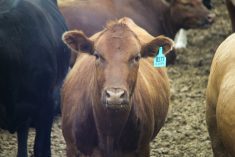When purchasing or selling livestock, their health status — preventive shots given, deworming, and other relevant information — can be determined by a few simple questions.
But these questions are seldom asked in cattle transactions these days. With cattle being of higher value, and often traversing long distances through different geographic areas, this information is extremely valuable.
When purchasing cattle, it is imperative to get the complete vaccination history for several reasons. Firstly, you need to confirm the initial and booster shots were given for the diseases most prevalent in your specific area. Have vaccinations for all the diseases you need to be protected from been administered or are there other things you need to carry out from a preventive medicine standpoint? Will these diseases have to be boostered? If something new shows up on the vaccinations, you may want to include that protocol in the revaccination. A good example of this would be leptospirosis, which is more common in Eastern Canada but relatively rare out west.
Read Also

Grazing ‘sweet spot’ boosts pasture performance
Timing-focused approach to pasture management touted to boost forage growth, livestock gains while also cutting farmer labour and inputs
Make sure you recognize other hidden things on your purchases, such as checking for internal parasites. Knowing the area the cattle have come from may give you some idea of other things one has to protect for from a biosecurity standpoint.
With any new purchases, a standard quarantine is a good idea for at least a couple of weeks. If, for instance, a respiratory disease is incubating and becomes evident during the quarantine, it can be treated. This is not indicative or caused by the original location but rather the stress of transporting, exposure at auction facilities, weather changes, commingling, and potential exposure to what may be on your farm. Common micro-organisms on your farm allow the cattle to have natural exposure and immunity develops over time. Cattle being brought in could be exposed to organisms your cattle are carrying which they are not immune to.
Other diseases may not show up for several years. So ones such as bovine leucosis (a bit more prominent in Eastern Canada) and Johne’s can be tested for if there’s a possibility of it being introduced to your herd.
The absolute worst time to purchase and introduce animals to your herd is just before calving season — yet this is when many purchases are made. The issue here is the bred animals may not develop protection in their colostrum for the scour organisms and other micro-organisms present on your farm. If you do purchase commercial or purebred cattle, make sure to find out if scours prevention was given so you have some idea of what protection the newborn calf is going to have in the mother’s colostrum.
Just because the purchase comes from a high-reputation herd does not guarantee the vaccination program is as comprehensive as you want, or need, on your premises. If you isolate the purchase, that gives you time to start a vaccination program — especially when it comes to scours prevention. The reverse could also be true whereby purchased animals can expose your herd to infectious agents. If it’s a new organism and your herd is essentially naive, infection is a possibility.
The measuring stick for good management is often how comprehensive an owner’s vaccination program is, such as whether parasite (both internal and external) control is given in a strategic manner.
It is too bad RFID tag information from the CCIA can not be passed down, but some tracking programs (such as BIXS, Herdtrax, and ViewTrak) are allowing information to be shared between purchaser and seller.
In the event of purchases from purebred sales, a better job could be done describing what has been done to the cattle. If possible, simply ask the question directly of the seller. If this communication network could be fine-tuned, it would be great. This would allow purchasers to add in what was needed without redundancy of duplication. (If information is lacking, definitely revaccinate to avoid any risks.)
The more information that is shared, the better. I know that feedlots bringing in and mixing cattle from all over, vaccinating with their protocols on entry is a must. It would still be good to know from a disease prevention standpoint if cattle had been pre-immunized (and with what vaccines). With the pressure to use less and less antimicrobials, communication of health information will go a long ways to help us work towards using less antimicrobials in cattle production.
Redundancy happens a great deal, and I am sure this is another cost we, as producers, must bear — whether from overvaccinating and overdeworming to giving too many metaphylactic drugs. This could be reduced if we communicate the great things we do down the line when we market cattle.
Preconditioned sales are one way this communication happens on a local level, but we also need to toot our own horn and really express what preventive things are done to our cattle. Whether it’s in sales catalogues, in satellite and internet auctions, or at the cattle auction markets, we must all accurately express all the great preventive and management procedures the cattle have benefited from. This will also minimize the necessity for antimicrobial usage and keep resistance at bay. Cattle producers are a responsible group — we just need to clarify this in all our cattle transactions.
When purchasing (especially purebred cattle), we look at phenotype, genetics, EPDs, growth, and so on. But health requirements are often overlooked.
Always ask questions as the health of your herd could be at stake. Vaccinations and other preventive management tasks need to be outlined, and it’s extremely helpful to know the dates when these measures were administered. By doing this, we also keep up to date on the latest vaccines and other technologies that are out there. For example, there are now several intranasal vaccines and painkillers that bring down fever and immune stimulants.
We can always learn something new from these discussions. Here’s to a healthy fall run for your cattle and those that you may purchase.
















